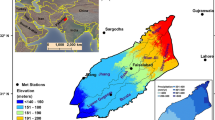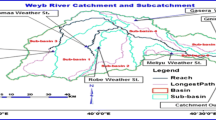Abstract
Climate change is one of the main driving forces that affect both the temporal and spatial variability of water availability. Besides climatic change, current demographic trends, economic development and related land use changes have direct impact on increasing demand for freshwater resources. Taken together, the net effect of these supply and demand changes has led to a growing water scarcity in major international river basins. The Brahmaputra River Basin is one of the most vulnerable areas in the world, as it is subject to combined effect of climate change and development pressures. A robust assessment of water scarcity considering both climatic and socio-economic changes is therefore vital for policy makers of the basin. In this study, we analyze future water scarcity of the Brahmaputra Basin in a geographically and temporally detailed manner, incorporating several novel approaches: (i) the application of consistent set of scenarios to estimate future water scarcity; (ii) estimation of water demand in terms of both water withdrawals and consumptive water use; (iii) comparison of water demand and availability on different temporal scales i.e., yearly, seasonal and monthly rather than only annual basis. (iv) assessment of groundwater recharge affected by climate change together with future demands for groundwater abstraction. Although the Brahmaputra Basin is one of the water abundant regions of the world, our analysis illustrates that during dry season water scarcity for the Basin will become more severe in the coming decades, which requires special attention to the decision makers of the authority.




Similar content being viewed by others
Notes
WEAP21 is a user-friendly software tool that takes an integrated approach to water resources planning.
References
Adam JC, Lettenmaier DP (2003) Adjustment of global gridded precipitation for systematic bias. J Geophys Res-Atmos 108:4257
Alcamo J, Henrichs T (2002) Critical regions: a model-based estimation of world water resources sensitive to global changes. Aquat Sci 64:352–362
Alcamo J, Döll P, Henrichs T, Kaspar F, Lehner B, Rosch T, Siebert S (2003) Global estimation of water withdrawals and availability under current and “business as usual” conditions. Hydrolog Sci J 48:339–348
Arnell NW (1999) Climate change and global water resources. Glob Environ Chang 9:31–49
Babel MS, Wahid SM (2008) Freshwater under threat South Asia: vulnerability assessment of freshwater resources to environmental change. United Nations Environment Programme, Nairobi
Beck L, Bernauer T (2011) How will combined changes in water demand and climate affect water availability in the Zambezi river basin? Glob Environ Chang 21:1061–1072
Bergström S (1995) The HBV model. In: Singh VP (ed) Computer models of watershed hydrology. Water Resources Publications, Highlands Ranch, pp 443–476
Chow VT, Maidment DR, Mays LW (1988) Applied hydrology. McGraw-Hill, New York
Döll P, Lehner B (2002) Validating of a new global 30-minute drainage direction map. J Hydrol 258:214–231
Falkenmark M, Lundqvist J, Widstrand C (1989) Macro-scale water scarcity requires micro scale approaches: aspects of vulnerability in semi arid development. Nat Resour Forum 13:258–267
Gaffin SR, Rosenzweig C, Xing X, Yetman G (2004) Downscaling and geo-spatial gridding of socio-economic projections from the IPCC Special Report on Emissions Scenarios (SRES). Glob Environ Chang 14:105–123
Gain AK, Schwab M (2012) An assessment of water governance trends: the case of Bangladesh. Water Policy 14:821–840
Gain AK, Immerzeel WW, Sperna Weiland FC, Bierkens MFP (2011) Impact of climate change on the stream flow of the lower Brahmaputra: trends in high and low flows based on discharge-weighted ensemble modelling. Hydrol Earth Syst Sci 15:1537–1545
Gain AK, Giupponi C, Renaud FG (2012) Climate change adaptation and vulnerability assessment of water resources systems in developing countries: a generalized framework and a feasibility study in Bangladesh. Water 4:345–366
Gain AK, Apel H, Renaud FG, Giupponi C (2013) Thresholds of hydrologic flow regime of a river and investigation of climate change impact—the case of the Lower Brahmaputra river Basin. Clim Chang 120:463–475
Goldewijk KK, Beusen A, van Drecht G, de Vos M (2011) The HYDE 3.1 spatially explicit database of human induced land use change over the past 12,000 years. Global Ecol Biogeogr 20:73–86
Hargreaves GH, Asce F, Allen RG (2003) History and evaluation of Hargreaves evapotranspiration equation. J Irrig Drain 129:53–63
Hoekstra AY, Mekonnen MM, Chapagain AK, Mathews RE, Richter BD (2012) Global monthly water scarcity: blue water footprints versus blue water availability. PLoS One 7(2):e32688
Hoff H, Swartz C, Yates D, Tielborger K (2007) Water management under extreme water scarcity: scenario analyses for the Jordan river basin, using WEAP21 [water evaluation and planning]. In: Lamaddalena N et al (eds) Water saving in Mediterranean agriculture and future research needs, vol 2. CIHEAM-IAMB, Bari, pp 321–331
Immerzeel W (2008) Historical trends and future predictions of climate variability in the Brahmaputra basin. Int J Climatol 28:243–254
Immerzeel WW, Bierkens MFP (2012) Asia’a water balance. Nat Geosci 5:841–842
Immerzeel WW, van Beek LP, Bierkens MFP (2010) Climate change will affect the Asian water towers. Science 328:1382–1385
Islam S, Oki T, Kanae S, Hanasaki N, Agata Y, Yoshimura K (2007) A grid-based assessment of global water scarcity including virtual water trading. Water Resour Manag 21:19–33
Kraaijenhoff van de Leur D (1958) A study of non-steady groundwater flow with special reference to a reservoir coefficient. De Ing 70:87–94
Kundzewicz ZW et al (2007) Freshwater resources and their management. In: Parry ML, Canziani OF, Palutikof JP, van der Linden PJ, Hanson CE (eds) Climate change 2007: impacts, adaptation and vulnerability. Contribution of Working Group II to the Fourth Assessment Report of the Intergovernmental Panel on Climate Change. Cambridge University Press, Cambridge, pp 173–210
Lehner B, Döll P (2004) Development and validation of a global database of lakes, reservoirs and wetlands. J Hydrol 296:1–22
Meigh JR, McKenzie AA, Sene KJ (1999) A grid-based approach to water scarcity estimates for Eastern and Southern Africa. Water Resour Manag 13:85–115
Mitchell TD, Jones PD (2005) An improved method of constructing a database of monthly climate observations and associated high-resolution grids. Int J Climatol 25:693–712
Mondal MS, Chowdhury JU, Ferdous MR (2010) Risk based evaluation for meeting future water demand of the Brahmaputra Floodplain within Bangladesh. Water Resour Manag 24:853–869
Oki T, Kanae S (2006) Global hydrological cycles and world water resources. Science 313:1068–1072
Oki T, Agata Y, Kanae S, Saruhashi T, Yang D, Musiake K (2001) Global assessment of current water resources using total runoff integrating pathways. Hydrol Sci J 46:983–996
Portmann F, Siebert S, Döll P (2010) MIRCA2000—global monthly irrigated and rainfed crop areas around the year 2000: a new high-resolution data set for agricultural and hydrological modelling. Global Biogeochem Cycles 24, GB1011
Postel SL, Daily GC, Ehrlich PR (1996) Human appropriation of renewable fresh water. Science 271:785–788
Rohwer J, Gerten D, Lucht W (2007) Development of functional types of irrigation for improved global crop modelling. PIK Report, 104. Potsdam Institute for Climate Impact Research, Potsdam
Shamsudduha M, Taylor RG, Longuevergne L (2012) Monitoring groundwater storage changes in the highly seasonal humid tropics: validation of GRACE measurements in the Bengal Basin. Water Resour Res 48, W02508
Shi P, Ma X, Hou Y, Li Q, Zhang Z, Qu S, Chen C, Cai T, Fang X (2013) Effects of land-use and climate change on hydrological processes in the Upstream of Huai River, China. Water Resour Manag 27:1263–1278
Siebert S, Döll P (2010) Quantifying blue and green virtual water contents in global crop production as well as potential production losses without irrigation. J Hydrol 384:198–217
Sophocleous M (2004) Global and regional water availability and demand: prospects for the future. Nat Resour Res 13:61–75
Taylor R (2009) Rethinking water scarcity: the role of storage. EOS Trans Am Geophys Union 90:237–238
Tiwari VM, Wahr J, Swenson S (2009) Dwindling groundwater resources in northern India, from satellite gravity observations. Geophys Res Lett 36, L18401
Turner AG, Annamalai H (2012) Climate change and the South Asian summer monsoon. Nat Clim Chang 2:587–595
Uppala SM et al (2005) The ERA-40 re-analysis. Q J R Meteorol Soc 131:2961–3012
Van Beek LPH, Wada Y, Bierkens MFP (2011) Global monthly water stress: I. Water balance and water availability. Water Resour Res 47, W07517
Vörösmarty CJ, Green P, Salisbury J, Lammers RB (2000) Global water resources: vulnerability from climate change and population growth. Science 289:284–288
Vörösmarty CJ, Douglas EM, Green PA, Revenga C (2005) Geospatial indicators of emerging water stress: an application to Africa. Ambio 34:230–236
Wada Y, Van Beek LPH, van Kempen CM, Reckman JWTM, Vasak S, Bierkens MFP (2010) Global depletion of groundwater resources. Geophys Res Lett 37, L20402
Wada Y, Van Beek LPH, Bierkens MFP (2011a) Modelling global water stress of the recent past: on the relative importance of trends in water demand and climate variability. Hydrol Earth Syst Sci 15:3785–3808
Wada Y, Van Beek LPH, Viviroli D, Dürr HH, Weingartner R, Bierkens MFP (2011b) Global monthly water stress: 2. Water demand and severity of water stress. Water Resour Res 47:W07518
Wada Y, Van Beek LPH, Bierkens MFP (2012a) Nonsustainable groundwater sustaining irrigation: a global assessment. Water Resour Res 48, W00L06
Wada Y, Van Beek LPH, Sperna Weiland FC, Chao BF, Wu YH, Bierkens MFP (2012b) Past and future contribution of global groundwater depletion to sea-level rise. Geophys Res Lett 39, L09402
Acknowledgments
The authors thank associate editor and anonymous reviewer for their constructive comments. Part of this research was conducted at Ca’ Foscari University of Venice and at Utrecht University, whose financial support is gratefully acknowledged. The authors are grateful to Bangladesh Water Development Board for providing the discharge data.
Author information
Authors and Affiliations
Corresponding author
Electronic supplementary material
Below is the link to the electronic supplementary material.
ESM 1
(DOC 356 kb)
Rights and permissions
About this article
Cite this article
Gain, A.K., Wada, Y. Assessment of Future Water Scarcity at Different Spatial and Temporal Scales of the Brahmaputra River Basin. Water Resour Manage 28, 999–1012 (2014). https://doi.org/10.1007/s11269-014-0530-5
Received:
Accepted:
Published:
Issue Date:
DOI: https://doi.org/10.1007/s11269-014-0530-5




